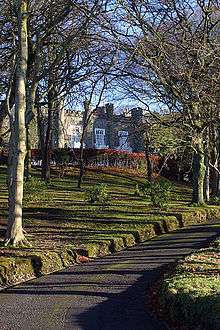Greeba Castle

Greeba Castle (Scandinavian: Gnipa, a peak)[1] is situated between the 5th and 6th Milestone road-side markers on the Snaefell Mountain Course used for the Isle of Man TT Races on the junction of the primary A1 Douglas to Peel road in the parish of German in the Isle of Man.
Greeba Castle is situated adjacent to the primary A1 Douglas to Peel road in the main Douglas to Peel central valley. The River Dhoo and the former Douglas to Peel railway line runs parallel to the primary A1 main road through the parishes of German, Marown and Braddan. The nearby area to Greeba Castle is mainly farmland including the Greeba River and the former Greeba Curragh with the nearby summits of Greeba Mountain (422 m) Cronk Breck (245 m), Cronk-ny-Moghlane (189 m) and Slieau Ruy (479 m).
At the base of Greeba Mountain and the Greeba or Kings Plantation there are two Victorian castellated residences built in 1849 to the Gothic style. These houses, Greeba Towers and Greeba Castle built in an elevated position were designed by John Robinson of Douglas, a self-taught architect designing many properties in the town of Douglas including the Bank of Mona (now the Tynwald Building), the Falcon Cliff, Douglas Head Hotel and the Derby Castle all with the castellated style and Gothic influence.[2] The house was originally built for William Nowell but it was subsequently bought by Edward Windus, the son of a partner of the publisher, Chatto & Windus.[3] The Victorian novelist Hall Caine moved to the Isle of Man in 1894 and rented Greeba Castle for a six-month period before residing briefly in Peel. The house, in a poor state of repair, was then purchased by Caine in 1896 and some remodelling of it occurred during the time of his residency which lasted until his death in 1931.[4]
Greeba Castle was part of the Four Inch Course used for the Tourist Trophy car races held between 1905 and 1922, and was part of the course used for 1905 International Motor Cycle Cup races. It is part of the Snaefell Mountain Course used since 1911 for the Isle of Man TT and from 1923 for the Manx Grand Prix races.
Sources
- ↑ Place Names of the Isle of Man by John Kneen MA pp.396 (1970) Yn Cheshaght Ghailckagh The Scolar Press
- ↑ Manx Sun June 1890
- ↑ Hall Caine: A Victorian Romancer by Vivian Allen, Sheffield University Press: Sheffield, 1997, p.225
- ↑ An Illustrated Encyclopedia of the Isle of Man by David T.Webber Revised by Frank Cowin and F.J.Radcliffe page 68 (1997) The Manx Experience The Alden Press, Oxford. ISBN 1-873120-25-7
External links
Coordinates: 54°11′35″N 4°35′20″W / 54.19306°N 4.58889°W